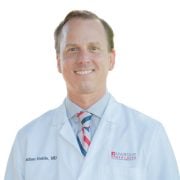
Author: Nathan Kiskila, MD
May is Stroke Awareness Month. Every minute counts when someone is possibly having a stroke. The longer left untreated, the higher the risk for brain damage and permanent disability to occur. Typically, the best outcomes are of those who recognized the symptoms early and were treated within 3 hours of the onset.
Remember to think FAST! Face, Arms, Speech, and Time, also known as “FAST,” are the cardinal signs in determining if someone is experiencing a stroke. Deemed a medical emergency, a stroke is when the blood supply to part of the brain is interrupted and/or severely reduced, causing the brain to lose functionality throughout various parts of the body.
Cautionary awareness when suspecting a stroke is crucial in improving chances of survival and in sustaining treatment. To prevent further brain damage, learn the FAST warning signs.
Face – Does one side of the face droop?
Arms – Is one arm weak or numb?
Speech – Is speech impaired or slurred?
Time – Is it time to call 911? If exhibiting any of the signs, emergency actions are to be taken.
Different Forms of Strokes:
- Ischemic strokes: Arteries to the brain become narrowed or blocked
- Hemorrhagic strokes: A blood vessel ruptures or leaks in the brain
- TIA (transient ischemic attack): Also known as a “mini stroke,” is a temporary decrease in blood supply allowing brief symptomatic periods similar to those of a stroke but often last no more than 5 minutes
Certain circumstances may increase one’s risk of stroke, including but not limited to various lifestyle risk factors, such as obesity, physical inactivity, heavy alcohol consumption, and substance abuse. Although treatable, more severe risk factors include: high blood pressure, high cholesterol, diabetes, cardiovascular disease, and cigarette smoking.
Diagnosing a stroke in preparation for treatment can be administered through blood tests, physical exams, CT/MRI scans, and electrocardiograms. Understanding stroke risk factors, following doctor recommendations, and adopting a healthy lifestyle are the best steps to take in preventing a stroke from occurring.
Preventative actions in combating the likelihood of stroke may include: controlling high blood pressure, lowering the amount of cholesterol and saturated fat intake, maintaining a healthy weight, eating a diet rich in fruits and vegetables, and exercising regularly. Antiplatelet drugs, and/or anticoagulants (blood thinners) are medications that may be considered valuable, as well.
A stroke can be detected and possibly prevented when the common signs and symptoms are immediately recognized. Remember to think FAST!
The information provided is for general interest only and should not be misconstrued as a diagnosis, prognosis or treatment recommendation. This information does not in any way constitute the practice of medicine, or any other health care profession. Readers are directed to consult their health care provider regarding their specific health situation. Marque Medical is not liable for any action taken by a reader based upon this information.

